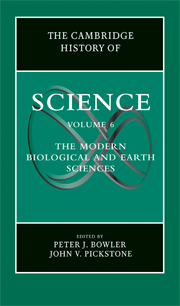Book contents
- Frontmatter
- 1 Introduction
- PART I WORKERS AND PLACES
- PART II ANALYSIS AND EXPERIMENTATION
- 10 Geology
- 11 Paleontology
- 12 Zoology
- 13 Botany
- 14 Evolution
- 15 Anatomy, Histology, and Cytology
- 16 Embryology
- 17 Microbiology
- 18 Physiology
- 19 Pathology
- PART III NEW OBJECTS AND IDEAS
- PART IV SCIENCE AND CULTURE
- Index
- References
18 - Physiology
from PART II - ANALYSIS AND EXPERIMENTATION
Published online by Cambridge University Press: 28 November 2009
- Frontmatter
- 1 Introduction
- PART I WORKERS AND PLACES
- PART II ANALYSIS AND EXPERIMENTATION
- 10 Geology
- 11 Paleontology
- 12 Zoology
- 13 Botany
- 14 Evolution
- 15 Anatomy, Histology, and Cytology
- 16 Embryology
- 17 Microbiology
- 18 Physiology
- 19 Pathology
- PART III NEW OBJECTS AND IDEAS
- PART IV SCIENCE AND CULTURE
- Index
- References
Summary
Among the modern life sciences, physiology trails only the evolutionary sciences in the attention it has received from historians. Lamarck, Darwin, and Mendel may be better known than the heroes of modern physiology, but names such as François Magendie (1783–1855), Johannes Müller (1801–1858), Claude Bernard (1813–1878), Hermann von Helmholtz (1821–1894), Ivan Pavlov (1849–1936), and Charles Sherrington (1857–1952) require little introduction for those who read more than occasionally in the history of science. Physiology may have attracted such attention because it has been widely viewed as the first of the modern biological disciplines to emerge from traditional approaches to the phenomena of life embodied in medicine and natural history. Furthermore, physiology allowed historians of science of the first generation after World War II to develop a series of narratives that reflected their broader concerns about the nature and significance of modern science and about how to write its history. If the historiography of the physical sciences in the 1950s and 1960s found its normative models in the “Scientific Revolution” of the sixteenth and seventeenth centuries, so, too, in those decades did historians of the life sciences locate their normative models in nineteenth-century physiology.
- Type
- Chapter
- Information
- The Cambridge History of Science , pp. 342 - 366Publisher: Cambridge University PressPrint publication year: 2009
References
- 6
- Cited by



